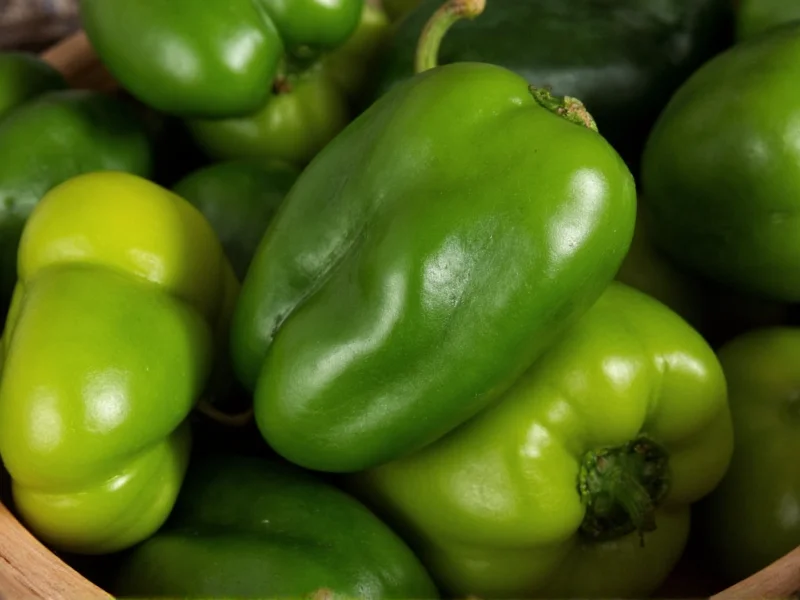Understanding where poblano peppers fall on the heat spectrum is essential for home cooks and culinary enthusiasts who want to use them effectively in recipes. Unlike their spicier cousins, poblanos offer a subtle warmth that enhances dishes without overwhelming other flavors. This characteristic makes them incredibly versatile in Mexican and Southwestern cuisine, where they're frequently stuffed, roasted, or incorporated into sauces.
Decoding the Scoville Scale for Poblano Peppers
The Scoville scale measures the concentration of capsaicin—the compound responsible for a pepper's heat—in Scoville Heat Units (SHU). Developed by pharmacist Wilbur Scoville in 1912, this scale remains the standard for quantifying pepper heat. Poblanos register between 1,000-2,000 SHU, which means they're:
- Much milder than jalapeños (2,500-8,000 SHU)
- About 5-10 times milder than habaneros (100,000-350,000 SHU)
- Slightly hotter than bell peppers (0 SHU), which contain no capsaicin
- Comparable to pepperoncini (500-500 SHU) but with a more complex flavor profile
It's important to note that heat levels can vary based on growing conditions, soil composition, and even the specific plant. A poblano grown in hotter, drier conditions may develop more capsaicin and thus more heat than one grown in cooler, more humid environments—a phenomenon known as environmental stress response.
Poblano Heat Compared to Common Peppers
| Pepper Type | Scoville Heat Units (SHU) | Heat Level Description |
|---|---|---|
| Poblano | 1,000-2,000 | Mild to medium, earthy flavor |
| Jalapeño | 2,500-8,000 | Moderate heat, grassy flavor |
| Serrano | 10,000-23,000 | Hot, bright flavor |
| Habanero | 100,000-350,000 | Very hot, fruity flavor |
| Bell Pepper | 0 | No heat, sweet flavor |
| Pepperoncini | 100-500 | Very mild, slightly tangy |
Factors That Influence Poblano Pepper Heat
Several elements can affect the actual heat level you experience when cooking with poblanos:
Plant Maturity
As poblano peppers mature and change color from dark green to reddish-brown, their heat level increases slightly. Fully ripe red poblanos tend to be at the higher end of the heat spectrum (closer to 2,000 SHU) compared to their green counterparts.
Growing Conditions
Peppers produce more capsaicin when stressed by factors like:
- Water scarcity
- Higher temperatures
- Poor soil conditions
This explains why the same poblano variety might taste noticeably different depending on where and when it was grown.
Individual Variation
Even within the same plant, heat levels can vary significantly between peppers. The seeds and white pith (placenta) contain the highest concentration of capsaicin, so removing these parts reduces heat substantially—a useful technique when working with unexpectedly hot poblanos.
Culinary Applications of Poblano Peppers
The mild heat profile of poblanos makes them exceptionally versatile in the kitchen. Unlike hotter peppers that can dominate a dish, poblanos contribute a subtle warmth that complements rather than overwhelms other ingredients.
Traditional Mexican Dishes
Poblanos shine in classic preparations like:
- Chiles Rellenos—stuffed with cheese or meat and battered
- Chiles en Nogada—stuffed poblanos in walnut sauce with pomegranate
- Rajas con Crema—sliced roasted poblanos in cream sauce
Cooking Tips for Managing Poblano Heat
When working with poblano peppers, consider these techniques to control heat levels:
- Roast and peel—this process slightly reduces heat while enhancing flavor
- Remove seeds and membranes—eliminates up to 80% of the capsaicin
- Soak in milk or cream—dairy neutralizes capsaicin effectively
- Pair with acidic ingredients—lime juice or tomatoes can balance perceived heat
Common Misconceptions About Poblano Heat
Several misunderstandings persist about poblano pepper heat levels:
"Poblanos are the same as pasilla peppers"
While dried poblanos are called ancho peppers, pasilla peppers are actually dried chilaca peppers—a completely different variety. Ancho peppers (dried poblanos) have a slightly sweeter, fruitier flavor but similar heat levels to fresh poblanos.
"All poblanos taste the same"
As mentioned earlier, heat can vary significantly between individual peppers and growing seasons. Two poblanos from the same grocery store batch might deliver noticeably different heat experiences.
"Poblanos are too hot for mild palates"
Compared to many other chili varieties, poblanos are exceptionally mild. Most people with average spice tolerance find them perfectly enjoyable, especially when seeds and membranes are removed. They're an excellent entry point for those exploring chili peppers beyond bell peppers.
When Poblanos Might Surprise You
Though generally mild, poblanos can occasionally deliver unexpected heat for several reasons:
- Overripe specimens—as they turn red, heat increases
- Stressed growing conditions—drought or extreme heat
- Cross-pollination—if grown near hotter pepper varieties
- Individual sensitivity—some people are naturally more sensitive to capsaicin
If you encounter an unusually hot poblano, don't panic. Simply remove the seeds and inner membranes, which contain most of the capsaicin. You can also balance the heat by adding dairy products like sour cream or cheese, or by incorporating sweet elements like corn or roasted vegetables.
Perfect Pairings for Poblano Peppers
The mild heat and rich flavor of poblanos make them compatible with numerous ingredients:
- Cheeses—Oaxaca, queso fresco, and Monterey Jack complement poblano's earthiness
- Proteins—chicken, pork, and beans create balanced flavor profiles
- Vegetables—corn, tomatoes, and onions enhance their natural sweetness
- Spices—cumin, oregano, and garlic deepen their complex flavor
For those exploring poblano heat levels in cooking, start with small quantities and adjust based on your personal tolerance. Remember that cooking concentrates flavors, so a dish may taste spicier when served than while preparing.











 浙公网安备
33010002000092号
浙公网安备
33010002000092号 浙B2-20120091-4
浙B2-20120091-4